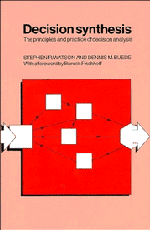7 - ANALYTIC TACTICS
from PART II - PRACTICE
Published online by Cambridge University Press: 16 September 2009
Summary
INTRODUCTION
In the previous chapter we discussed the strategic choices that the analyst has in conducting an analysis of a decision. While these strategic approaches vary considerably and on many dimensions, there a number of skills (or tools) that the analyst needs to complete any one strategy, and these skills are amazingly common across all strategies.
First in Section 7.2 we will talk about structuring, by which we mean both the definition of the problem and the identification of the elements of the model to be used in analyzing the alternatives. The choice of an analytic strategy is included in problem-structuring. Also included in this section is some practical advice on how to get the analysis started and a philosophical, yet pragmatic, view of modeling.
The third section of this chapter addresses the use of iterative analysis, the sequential application of structuring and quantification. Four types of iterative analysis are discussed, followed by a discussion of how to use iterative analysis in deciding how much analysis to do.
Probability elicitation occupies Section 7.4. Research findings on good and bad ways to assess probabilities are summarized before an encoding process is described. Finally we comment on the discretization of continuous probability distributions for decision tree analysis.
- Type
- Chapter
- Information
- Decision SynthesisThe Principles and Practice of Decision Analysis, pp. 163 - 214Publisher: Cambridge University PressPrint publication year: 1988



